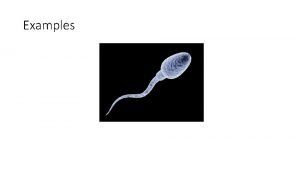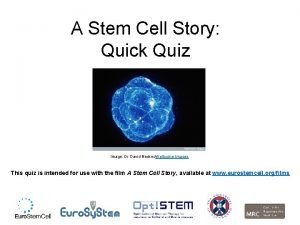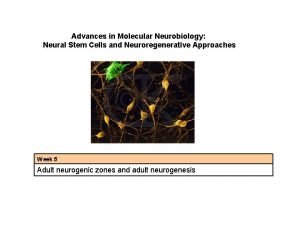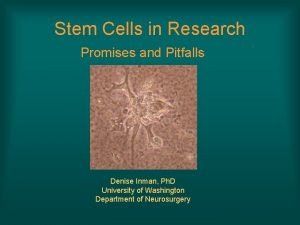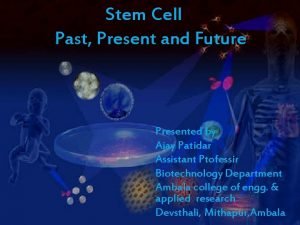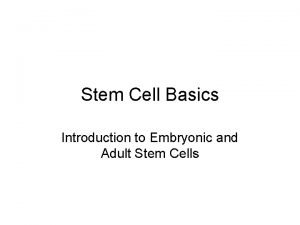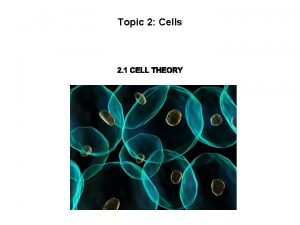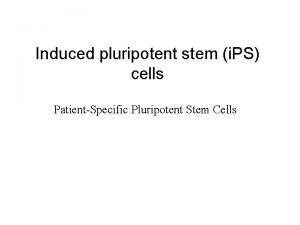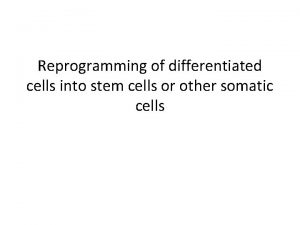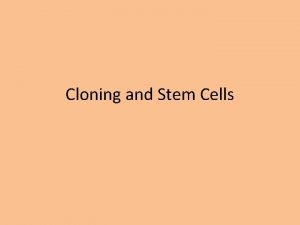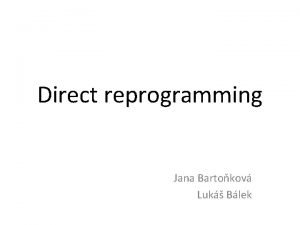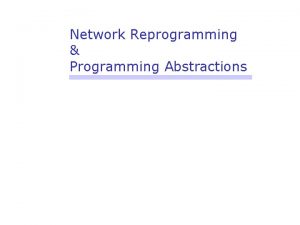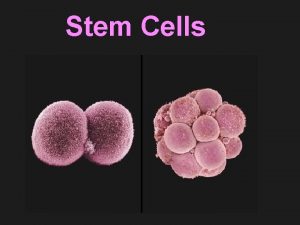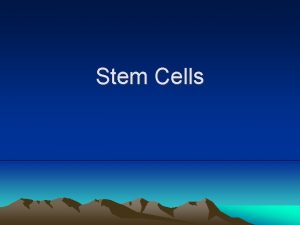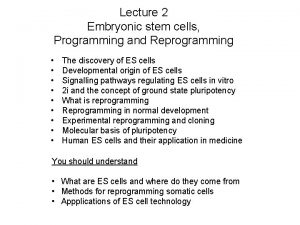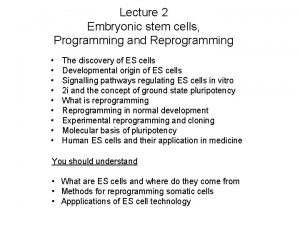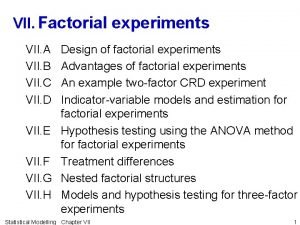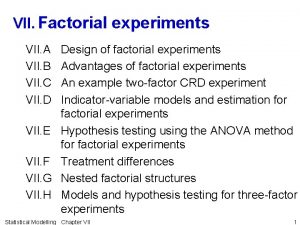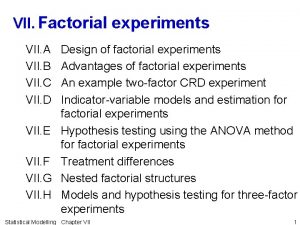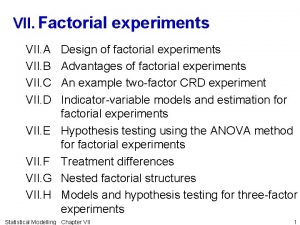Cell Reprogramming and Pluripotent Stem Cells Class VII

















- Slides: 17

Cell Reprogramming and Pluripotent Stem Cells Class VII M. Sc. -Semester IV Dr. Hifzur R Siddique Section of Genetics Department of Zoology ALIGARH MUSLIM UNIVERSITY

Reprogramming of a Transplanted Nucleus Involves Drastic Epigenetic Changes ØIn a typical fully differentiated cell, there seem to be mechanisms maintaining the pattern of gene expression that cytoplasmic factors cannot easily override. ØAn obvious possibility is that the stability of the pattern of gene expression in an adult cell may depend, in part at least, on selfperpetuating modifications of chromatin. ØThe phenomenon of X-inactivation in mammals provides a clear example of such epigenetic control. ØTwo X chromosomes exist side by side in each female cell, exposed to the same chemical environment, but while one remains active, the other persists from one cell generation to the next in a condensed inactive state; cytoplasmic factors cannot be responsible for the difference, which must instead reflect mechanisms intrinsic to the individual chromosome.

ØThe reprogramming of a nucleus transplanted into an oocyte involves dramatic changes in chromatin. ØThe nucleus swells, increasing its volume 50 -fold as the chromosome decondense; there is a wholesale alteration in patterns of methylation of DNA and histones. ØThe standard histone H 1 is replaced by a variant form that is peculiar to the oocyte and early embryo; and the preexisting type of histone H 3 is also replaced at many sites by a distinct isoform. ØEvidently, the egg contains factors that reset the state of the chromatin in the nucleus, wiping out old histone modifications on chromatin and imposing new ones. ØReprogrammed in this way, the genome becomes competent once again to initiate embryonic development and to give rise to the full range of differentiated cell types.

Embryonic Stem (ES) Cells Can Generate Any Part of the Body v Fertilized egg or equivalent cell produced by nuclear transplantation: can generate a whole new individual, and that means that it can give rise to every normal type of specialized cell, including even egg or sperm cells for production of the next generation. v A cell in such a state is said to be TOTIPOTENT; it is said to be pluripotent if it can give rise to most cell types but not absolutely all. v Take an early mouse embryo, at the blastocyst stage, and through cell culture to derive from it a class of stem cells called embryonic stem cells, or ES cells. v These originate from the inner cell mass of the early embryo (the cluster of cells that give rise to the body of the embryo proper, as opposed to extraembryonic structures). v They have an extraordinary property: given suitable culture conditions, they will continue proliferating indefinitely and yet retain an unrestricted developmental potential. v Their only limitation is that they do not give rise to extraembryonic tissues such as those of the placenta. v Thus they are classified as PLURIPOTENT, RATHER THAN TOTIPOTENT. v But this is a minor restriction. If ES cells are put back into a blastocyst, they become incorporated into the embryo and can give rise to all the tissues and cell types in the body, integrating perfectly into whatever site they may come to occupy, and adopting the character and behavior that normal cells would show at that site.

v They can even give rise to germ cells, from which a new generation of animals can be derived. v ES cells let us move between cell culture, where we can use powerful techniques for genetic transformation and selection, and the intact organism, where we can discover how such genetic manipulations affect development and physiology. v Thus, ES cells have opened the way to efficient genetic engineering in mammals, leading to a revolution in our understanding of mammalian molecular biology. v Cells with properties similar to those of mouse ES cells can now be derived from early human embryos and fetal germ cells, and even, as we shall explain below, from differentiated cells taken from adult mammalian tissues. In this way, one can obtain a potentially inexhaustible supply of pluripotent cells. v Grown in culture, these can be manipulated, by suitable choice of culture conditions, to give rise to large quantities any type of differentiated cell, opening the way to important practical applications.

A Core Set of Transcription Regulators Defines and Maintains the ES Cell State v. What is it that gives ES cells and related types of pluripotent stem cells their extraordinary capabilities? v. An essential feature of ES cells is that they must avoid senescence. Many somatic cells: they are limited in the number of times they will divide, in part at least because they lack telomerase activity, with the result that their telomeres become progressively eroded in each division cycle, leading eventually to cell-cycle arrest. v. ES cells, by contrast, express high levels of active telomerase, allowing them to escape senescence and continue dividing indefinitely. v. This is a property shared with other, more specialized types of stem cells, such as those of the adult intestine, which similarly can carry on dividing for hundreds or thousands of cycles. v. The deeper problem is to explain how the whole complex pattern of gene expression in an ES cell is organized and maintained.

v. As a first step, one can look for genes expressed specifically in ES cells or in the corresponding pluripotent cells of the early embryo. v. This approach identifies a relatively small number of candidate EScritical genes; that is, genes that seem to be essential in one way or another for the peculiar character of ES cells. v. A gene called Oct 4, for example, is exclusively expressed in ES cells and in related classes of cells in the intact organism-specifically, in the germ-cell lineage and in the inner cell mass and its precursors. v. Oct 4 codes for a transcription regulator. When it is lost from ES cells, they lose their ES cell character; and when it is missing in an embryo, the cells that should specialize as inner cell mass are diverted into an extraembryonic pathway of differentiation and their development is aborted.

Fibroblasts Can Be Reprogrammed to Create Induced Pluripotent Stem Cells (i. PS Cells) v. Fibroblasts and some other cell types can be driven to switch their character and differentiate as muscle cells if the master muscle-specific transcription regulator Myo. D is artificially expressed in them. v. Could the same technique be used to convert adult cell types into ES cells, through forced expression of factors such as Oct 4? v. This question was tackled by transfecting fibroblasts with retroviral vectors carrying genes that one might hope to have such an effect. v. A total of 24 candidate ES-critical genes were tested in this way. None of them was able by itself to cause the conversion; but in certain combinations they could do so. v. In 2006, the first breakthrough experiments whittled down the requirement to a core set of four factors, all of them transcription regulators: Oct 4, Sox 2, Klf 4, and Myc, known as the OSKM factors for short. v. When co-expressed, these could reprogram mouse fibroblasts, permanently converting them into cells closely similar to ES cells. ES-like cells created in this way are called induced pluripotent stem cells, or i. PS cells. Like ES cells, i. PS cells can continue dividing indefinitely in culture, and when incorporated into a mouse blastocyst they can participate in creation of a perfectly formed chimeric animal.

v i. PS cells can now be derived from adult human cells and from various other differentiated cell types besides fibroblasts. v Numerous methods can be used to drive expression of the transforming OSKM factors, including methods that leave no trace of foreign DNA in the reprogrammed cell. v Variations of the original cocktail of transcription regulators can drive the conversion, with different specialized cell types having somewhat different requirements. Myc overexpression, for example, turns out not to be absolutely necessary, although it enhances the efficiency of the process. v Differentiated cells express some of the required factors as part of their normal phenotype. v v For example, cells of the dermal papilla of hair follicles already express Sox 2, Klf 4, and Myc; to convert them into i. PS cells, it is enough to force them artificially to express Oct 4, indeed, seems to have a central role and to be generally indispensable for the creation of i. PS cells.

Reprogramming Involves a Massive Upheaval of the Gene Control System v The experiment makes use of a gene (Fbx 15) that is present in all cells but is normally expressed only in ES and early embryonic cells (although not required for their survival). v A fibroblast cell line is genetically engineered to contain a gene that produces an enzyme that degrades G 418 under the control of the Fbx 15 regulatory sequence. v G 418 is an aminoglycoside antibiotic that blocks protein synthesis in both bacteria and eukaryotic cells. When the OSKM factors are artificially expressed in this cell line, a small proportion of the cells undergo a change of state and activate the Fbx 15 regulatory sequence, driving expression of the G 418 -resistance gene. v When G 418 is added to the culture medium, these are the only cells that survive and proliferate. When tested, they turn out to have an i. PS character.


An Experimental Manipulation of Factors that Modify Chromatin Can Increase Reprogramming Efficiencies

ES and i. PS Cells Can Be Guided to Generate Specific Adult Cell Types and Even Whole Organs

v A- Remarkably, under appropriate conditions, mouse ES cells in culture can proliferate, differentiate, and interact to form a three-dimensional, eye-like structure, which includes a multilayered retina similar in organization to the one that forms in vivo. v B- Fluorescent micrograph of an optic cup formed by ES cells in culture. The structure includes a developing retina, containing multiple layers of neural cells, which produce a protein (pink) that serves as a marker for retinal tissue. (Nature 472: 51– 56, 2011.

Cells of One Specialized Type Can Be Forced to Transdifferentiate Directly Into Another • Could we not convert cell type A into cell type B directly, without backtracking to the embryonic-like i. PS state? • For many years, it has been known that such transdifferentiation can be achieved in a few special cases, such as the conversion of fibroblasts into skeletal muscle cells by forced expression of Myo. D. • But now, with the insights that have come from the study of ES and i. PS cells, ways are being found to bring about such interconversions in a much wider range of cases. • An elegant example comes from studies of the heart. By forcing expression of an appropriate combination of factors-not Oct 4, Sox 2, Klf 4, and Myc, but Gata 4, Mef 2 c, and Tbx 5—it is possible to convert heart fibroblasts directly into heart muscle cells. This has been done in the living mouse, using retroviral vectors, and the transformation occurs with high efficiency when the vectors carrying the transgenes are injected directly into the heart muscle tissue itself. • Although they occupy only a small fraction of the tissue volume, the fibroblasts in the heart outnumber the heart muscle cells, and they survive in large numbers even where the heart muscle cells have died. Thus, in a typical nonfatal heart attack, where heart muscle cells have died for lack of oxygen, the fibroblasts proliferate and make collagenous matrix so as to replace the lost muscle with a fibrous scar. • This is a poor sort of repair. By forcing expression of the appropriate factors in the heart, as described above, it has proved possible, in the mouse at least, to do better than nature and regenerate lost heart muscle by transdifferentiation of heart fibroblasts.

ES and i. PS Cells Are Useful for Drug Discovery and Analysis of Disease

K N A H T U O Y
 Pluripotent stem cells examples
Pluripotent stem cells examples Sphenoid paranasal sinus
Sphenoid paranasal sinus Red blood cells and white blood cells difference
Red blood cells and white blood cells difference Plant vs animal cells venn diagram
Plant vs animal cells venn diagram Masses of cells form and steal nutrients from healthy cells
Masses of cells form and steal nutrients from healthy cells Where can scientists obtain stem cells? *
Where can scientists obtain stem cells? * Stem cells
Stem cells Conclusion of stem cells
Conclusion of stem cells Images with creative commons license
Images with creative commons license Adult stem cells
Adult stem cells Stem cell classification chart
Stem cell classification chart Biochemistry questions
Biochemistry questions Outline one therapeutic use of stem cells
Outline one therapeutic use of stem cells Stem cells webquest
Stem cells webquest Stem cells specialization
Stem cells specialization Tubular lumen
Tubular lumen Pineal gland
Pineal gland How are mitosis and meiosis similar
How are mitosis and meiosis similar
